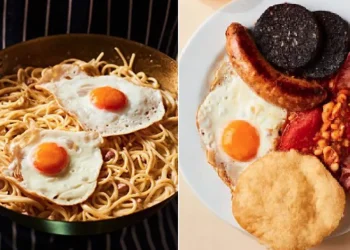After earning a spot earlier this year, the word “onigiri” is now included in the Oxford English Dictionary.
Evidence, if any was required, that the modest sticky-rice ball, a staple of Japanese cuisine, has made its way into the world tongue.
The rice balls are usually wrapped in seaweed after being filled with a variety of ingredients. This common dish perfectly embodies “washoku,” the traditional Japanese cuisine that was recognized as a Ten-Year Intangible Cultural Heritage by UNESCO.
Onigiri is “fast food, slow food, and soul food,” according to Tokyo trade organization leader Yusuke Nakamura of the Onigiri Society.
Quick since convenience stores also carry it. It’s slow because it incorporates sea and mountain elements, he explained. Additionally, soul food is produced and enjoyed frequently with family and friends. All you need are softly cupped hands; no equipment needed.
He added, “Food is on the move and it’s also mobile.”
The first known form of onigiri is thought to date back to the early 11th century; Murasaki Shikibu mentions it in “The Tale of Genji.” It makes an appearance in the iconic 1954 film “Seven Samurai” directed by Akira Kurosawa as the farmers’ ultimate token of appreciation.
The contents are referred to as “gu,” or filling. The salted plum, or umeboshi, is a perennial favorite. Or mentaiko, which is roe that is hot and spicy. However, anything can theoretically be put inside onigiri, including cheese or sausages.
Seaweed is then used to wrap the ball. Although many would eat more, even one great big onigiri would make a feast.
Some adhere to the traditional onigiri.
Onigiri Asakusa Yadoroku is a restaurant owned and operated by Yosuke Miura, whose grandmother opened it in 1954. Yadoroku is named for her husband, Miura’s grandpa, and means “good-for-nothing” in rough translation. It says it’s Tokyo’s oldest onigiri restaurant.
Only two tables are present. There are eight chairs at the counter. You can order takeout, but the wait time is still the same.
“Onigiri is loved by all,” grinned Miura from behind a wooden counter. Before him are bowls of gu with miso-flavored ginger, shrimp, and salmon in a display cabinet. “Basically, it’s nothing spectacular. Every Japanese person has consumed it.
Miura, a classical flautist as well, views onigiri as a score that his grandmother left behind and would replicate with accuracy.
“In classical music, you perform the notes as they are printed on the score. He states, “Onigiri is the same.” “You never try to try something different.”
Tucked away in Tokyo’s charming historic district of Asakusa sits Yadoruku. It opens at 11:30 a.m. and closes, generally within an hour, when it runs out of rice. After then, it reopens for supper. The priciest onigiri is 319 yen ($2), while the most costly is 770 yen ($4.90) with salmon roe. Miso soup is a part of that. There are no reservations accepted.
Miura’s regular onigiri are triangles, however they can be square, round, animal, or star shaped. In less than 30 seconds, he prepares them to order, right in front of your eyes.
He places the hot rice in triangular molds that look like cookie cutters, rubs salt on his hands and then cups the rice — three times to gently firm the sides. The crisp nori, or seaweed, is wrapped like a kerchief around the rice, with one end up so it stays crunchy.
The initial mouthful is just nori and rice. With your second bite is the gu.
With a smile, Miura declared, “The Yadoroku onigiri will not change until the end of Earth.”
Some, though, wish to try new things.
Taro Tokyo Onigiri, owned by Miyuki Kawarada, has four locations in Japan. She also has her sights on Los Angeles, followed by Paris. Making onigiri “the world’s fast food” was her goal.
Since Taro is the usual Japanese name for Michael or John, it was picked. She claims that onigiri’s widespread appeal stems from its ease of preparation, versatility, and lack of gluten.
She also points out that other Japanese dishes like sushi and ramen are now well-known throughout the world.
Workers in her bright, contemporary store are busy preparing the gu and rice balls in a kitchen that is visible behind the cash register. They are dressed in khaki-colored business T-shirts. The restaurant solely offers takeout.
Kawarada’s onigiri contains a lot of gu on top rather than inside for vibrant toppings. Each one has a piece of nori wrapped separately, which you wrap around it just before you eat.
Her gu starts taking risks. For example, cream cheese is combined with a strong Japanese pickle known as “iburigakko,” and each onigiri costs 250 yen ($1.60). The price of the onigiri with spam and egg is 300 yen ($1.90); the one with many varieties of edible kelp, or “kombu,” dubbed “Dashi Punch X3,” is 280 yen ($1.80).
“The infinite universe is Onigiri.” We don’t let tradition limit us,” Kawarada remarked.











